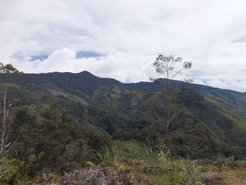Persistent Tropical Foraging in the Highlands of Terminal Pleistocene/Holocene New Guinea
Foraging lifestyles persisted in New Guinean tropical forest environments even after the advent of farming 8,000 years ago
The development of agriculture is frequently seen as one of the major economic, social, and demographic thresholds in human history. From the perspective of the modern world it is often seen as an inevitable, desirable subsistence strategy, allowing larger populations, settled life, and the development of cities. Likewise it has even been argued that long-term human survival in tropical forests must have been impossible without some form of agricultural system, with agriculture developing as a result of climatic or environmental instability.
However, these claims seem to be incorrect in the case of tropical New Guinea, as a recent study by a research crew from the Max Planck Institute for the Science of Human History, the University of Otago, and the University of Oxford has demonstrated. In tropical New Guinea, where one of the earliest human experiments with agriculture occurred, agriculture apparently never replaced foraging as a primary subsistence strategy: “Montane tropical forest environments provided a stable source of subsistence for human hunter-gatherers in New Guinea”, says Patrick Roberts, primary author of the study. “We have found out that foragers were living in close proximity to emerging farming groups, from 12,000 to 300 years ago, which indicates that agriculture was not a forced event in this part of the world.”

Tropical forests have frequently been perceived as unattractive habitats for humans – both foragers and farmers – due to poor soils, difficulties of humidity, and issues of reliable nutrition. However, archaeological work in New Guinea, among other tropical regions, has now helped to refute this idea: “We can now affirm that humans have occupied areas in this region, covered today in rainforest, from 45,000 years ago“, says…, Professor Glenn Summerhayes from the University of Otago, senior author of the study. “Some of the earliest evidence for the human development of agriculture comes precisely from the tropical forested portions of New Guinea.” Nevertheless, as Professor Summerhayes states “records of past environments that can be directly associated with these prehistoric human experiments are currently frequently lacking, meaning that the context of agriculture and wider human behaviour in this region remain poorly understood”.
Isotope analysis of small mammals reveals prehistoric diets and lifestyles
The recent study published in Nature Ecology and Evolution has addressed this gap in knowledge for the region by applying stable carbon and oxygen isotope analysis of fossil teeth to small regional mammals, like fruit bats, cuscus, ring-tailed possums, and macropods, to reconstruct the diets and environments of past human and animal populations. As Professor Julia Lee-Thorp from the University of Oxford, co-author of the study, points out, “it is only relatively recently that this method has been applied to small mammals. Due to their short life cycles and specialised adaptations, these animals are highly sensitive to environmental change making them perfect for obtaining a truly ‘local’ picture of vegetation”.
The team analysed the teeth of fruit bats, cuscus, ring-tailed possum and macropods from the archaeological site of Kiowa, which spans the origins of agriculture in the region (12,000-8,000 years ago), and beyond until around 300 years ago. These animals are locally well-studied, have known ecological behaviours, and are documented as being hunted by local foragers into recorded history.
The results provided a new, rare environmental record for the Central Highlands of New Guinea that indicated a stability, and persistent use, of local tropical forest environments across the period of human occupation of the site. “This research enriches our understanding of the origins of agriculture in the region, indicating that stable tropical environments supported both agricultural experimentation and ongoing tropical forest foraging within a small area”, states Dylan Gaffney of the University of Otago. “While intensive landscape modification and the domestication of plant taxa, including the banana, yam, and taro, occurred nearby, foragers continued to hunt and forage in tropical forest environments” states lead author, Patrick Roberts, of the Max Planck Institute for the Science of Human History.
Human survival in New Guinea – a continuum of farming and foraging
“While we often assume that agriculture is a desirable invention that replaced previous ways of obtaining food, in prehistoric New Guinea, agriculture is best seen as one part of a continuum of human survival strategies and certainly not as an inevitable development”, says Roberts. This work also demonstrates how new methods, such as stable isotope analysis of tooth enamel and laser scanning from aircraft, are deepening archaeological knowledge of past human tropical forest use, where poor preservation, due to acidic soils and heavy rainfall, and difficulty of survey, due to dense vegetation, have often limited archaeological research. “The successful long-term exploitation of these environments is a key part of the adaptive flexibility that characterises our species relative to our ancestors. Humans have been able to exploit them continuously, and in diverse ways, since their first arrival there 45,000 years ago until the present-day where the expansion of plantations, industry and urbanism threaten their ongoing existence”, concludes Roberts.
For more information, please contact the Max Planck Institute for the Science of Human History News Office at +49 (0)3641 686 601 or email: presse@shh.mpg.de
Notes for Editors
The paper, ‘Persistent tropical foraging in the highlands of terminal Pleistocene/Holocene New Guinea’ is by Patrick Roberts, Dylan Gaffney, Julia Lee-Thorp and Glenn Summerhayes.
The paper was co-authored by the Max Planck Institute for the Science of Human History, the University of Otago and the University of Oxford
